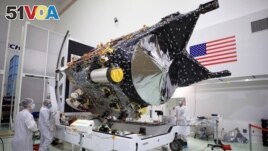NASA has successfully tested a laser-based communication method that sent data over 16 million kilometers. The American space agency hopes the system will greatly improve data links between Earth and spacecraft exploring deep space.
The method, called Deep Space Optical Communications (DSOC), is being tested aboard NASA's Psyche spacecraft. The agency launched Psyche last month to observe a mostly metal asteroid.
DSOC uses lasers to send large amounts of data very long distances. Traditionally, NASA has depended on radio frequency communications to send data to, and collect data from, deep space. But now the agency seeks to improve its systems to support new technologies and future trips to the moon and beyond.

NASA's Psyche spacecraft is shown in a clean room at the Astrotech Space Operations facility near the agency's Kennedy Space Center in Florida on Dec. 8, 2022. (NASA/Ben Smegelsky)
Laser communications, also known as optical communications, enable the fast transmission of data over long distances. In an explanation of lasers, NASA explained the technology will permit "up to 100 times more data to be transmitted back to Earth than current radio frequency systems."
NASA estimates it would take about nine weeks to transmit a complete map of Mars back to Earth with current radio frequency systems. But with a laser-based method, the time would be cut to nine days. Also, laser communications equipment takes up less space in spacecraft and uses less energy.
Scientists from NASA's Jet Propulsion Laboratory in California recently announced a successful test of the DSOC method. The team said a device on the Psyche spacecraft was able to successfully send and receive data messages with a telescope in Southern California. NASA said the laser system works with signals that exist at near-infrared wavelengths.
The data transmitted by laser takes the form of bits – the smallest pieces of data a computer can process. These bits are embedded inside the laser's photons.
The NASA team described the successful data signal transmissions as "first light." The experiment represented "the farthest-ever demonstration of optical communications," at about 16 million kilometers.
Trudy Kortes is the director of Technology Demonstrations for the Space Technology Mission Directorate at NASA Headquarters in Washington. She said in a statement she sees the first light event as one "of many critical DSOC milestones" to look forward to in the coming months. The communication success is another step forward, she said, "in support of humanity's next ... goal: sending humans to Mars."
Optical communication has already been demonstrated in low Earth orbit and on the moon. But the research team working on the DSOC project said it was the first time this method has been successfully tested in deep space.
Abi Biswas is a project technologist on the DSOC team. He called the latest laser test "a tremendous achievement." The team was, Biswas said, "able to send some data, meaning we were able to exchange ‘bits of light' from and to deep space."
The team said laser communication over long distances can be difficult as it requires complete exactness in following signals and linking up transmitters and receivers over millions of kilometers.
Project leaders say when Psyche is at its farthest from our planet, DSOC's near-infrared photons will take about 20 minutes to travel back to Earth. During the successful experiment on November 14, DSOC took about 50 seconds to send the data from Psyche to Earth.
Jason Mitchell is a director in NASA's Space Communications and Navigation program. He called optical communication "a boon for scientists and researchers who always want more from their space missions." Mitchell said better data transmission methods will improve human exploration of deep space" and lead to many more data discoveries in the future.
I'm Bryan Lynn.
Bryan Lynn wrote this story, based on reports from NASA.
_____________________________________________
Words in This Story
asteroid – n. an object made of rock and metal that orbits the sun, but is smaller than planets
transmit – v. to send
embed – v. to fix something firmly into a substance
milestone – n. an important event in history or the development of something or someone
achievement – n. something good that you achieve: to succeed in doing something good, usually by working hard
boon – n. something helpful that improves your life
